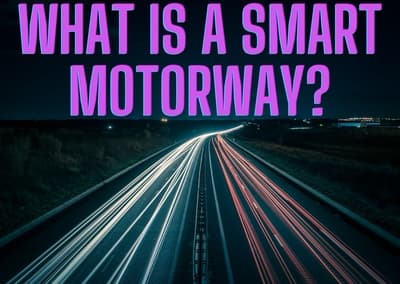What is a smart motorway?
Smart motorways have been a hot topic for some time. A lot of motorists in the UK seem to be on the fence when it comes to this topic, with some people seeing the benefits, but others seeing flaws with the new system. Despite what you think, smart motorways are here to stay, with 300 miles of motorway being adapted to this new system by the year 2025. In this article, we aim to give you a more in-depth understanding of smart motorways and answer any potential questions that you may have.

How does a smart motorway work?
I am sure that in your experience as a driver you have experienced heavy congestion on the motorway. The aim of the smart motorway is to try and avoid this and keep traffic going at a smooth and steady rate. This is done through a variety of active traffic management (ATM) techniques and new technology.
Some of these new features include –
Lane control signs
Lane control signs are electronic displays that are suspended above the motorway. The purpose of these signs are to give drivers instructions, with the ultimate aim of keeping traffic flowing. You will commonly see speed limits displayed on these lane control signs that vary over time depending on how well the traffic is moving. The speed shown on the lane control signs is the legal speed limit and is enforced with traffic cameras. You will also see a red X; this sign shows that the lane is closed for maintenance or an accident has occurred. Finally, another symbol you may see is a green arrow, that directs drivers into another lane on the motorway.
Variable message signs
The purpose of a variable message sign is too give drivers useful information. An example of this could be ‘High Winds’, indicating drivers to be cautious when driving. These signs will also tell drivers if there has been an accident, even though it may be a lot further up the motorway.
Hard shoulder opens to traffic
The hard shoulder has been made into another driveable lane, especially during busy times. The purpose of this is to reduce congestion during these busy times, allowing traffic to be more free-flowing. When the hard shoulder is in use, 2 new emergency refuge areas (ERA) have been built in the event of an emergency. The refuge areas will be equipped with sensors, CCTV and a phone.
What happens if I break down?
In the event that you find yourself breaking down on a smart motorway, it is important that you know what to do. Obviously, the priority would be to make it to an ERA, but in the event that you cannot make it and there is no hard shoulder, there are certain steps you should take. Firstly, put on your hazards to indicate to other drivers. If you can make it to the inside lane, pull up on the verge and exit the vehicle from the left side, standing behind the safety barrier and call Highway England on the phone provided at the ERA. If you cannot make it to the inside lane, remain calm and call 999 and ask for assistance, do not exit your car. Once the authorities are aware that you have broken down, they will close the lane by displaying a red X on the variable message sign.
Fines for smart motorways
If any of the procedures put in place such as the varying speed limits, or deliberately driving down a closed lane are broken, there will be consequences. Smart motorways are layered with speed cameras, if you are caught speeding then you could receive a penalty of up to £2500. If there is no displayed speed limit, the national speed limit is applied. If you continue down a closed lane marked with a red X, you can receive a fine of £100 and 3 points off your license. It is very dangerous to do this as there may have been an accident.
Did you enjoy this blog post? |5 people found this review helpful



 Sign up for SPECIAL OFFERS
Sign up for SPECIAL OFFERS
